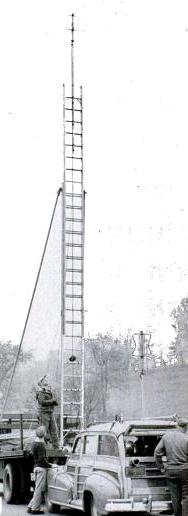 The contraption shown here was part of a 1950 RCA test of the capabilities of UHF television. The truck, carrying an extension ladder, cruised the streets of Bridgeport, Connecticut, to test the signal being put out by its experimental UHF television station, KC2XAK.
The contraption shown here was part of a 1950 RCA test of the capabilities of UHF television. The truck, carrying an extension ladder, cruised the streets of Bridgeport, Connecticut, to test the signal being put out by its experimental UHF television station, KC2XAK.
Inside the station wagon was a TV receiver evaluating the quality of the picture being received from the antenna atop the ladder.
The article from which this picture is taken, the August 1950 issue of Popular Science, points out that cities such as Bridgeport faced challenges getting television. With only twelve VHF channels allocated, the stations in New York had already filled the quota. Bridgeport was too far away for good over-the-air reception, but too close to use the same channels in use in New York or the adjacent ones. The solution was seen in setting up a “slave” UHF station. KC2XAK was rebroadcasting the signal of WNBT in New York, to about 100 homes in Bridgeport that had been equipped with UHF converters. The video was received by the relay station from a microwave feed from the Empire State Building. The audio was simply received over the air for retransmission.
The article noted that reception by the test households was good, and that UHF offered a promising way to deliver television to smaller cities.
Click Here For Today’s Ripley’s Believe It Or Not Cartoon ![]()
